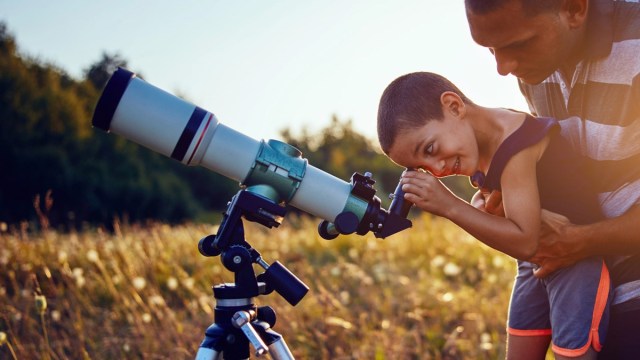Take an evening at home to learn about stargazing with the kids
Summer is the perfect time of year for stargazing, especially after school is out and the kids can stay up late. The key to stargazing is to pick a clear night and find a spot that’s away from the city lights and clear of trees. Want to leave the astronomy lesson to the experts? Plan a visit to a dark sky national park for their seasonal stargazing programs. Then check out our gear and tips to get the kids really jazzed about this outdoor activity!
First, Get Your Kids Interested
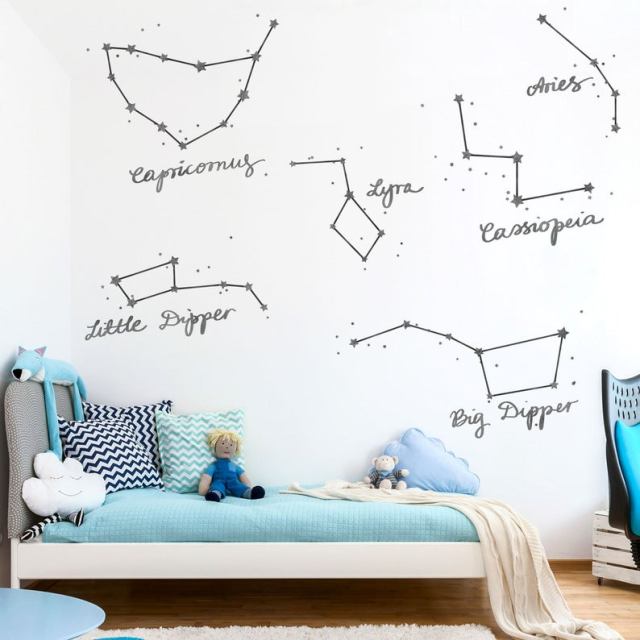
Sure, any kid will jump at the chance to stay up past bedtime with the family, but it's best to get your kids interested—or at least familiar with—the stars before heading out for a night of skywatching. Luckily, there are tons of books, games and gadgets out there to get them excited:
Bring the Stars Inside - Stick constellation stickers on your child’s ceiling to get her used to looking up and seeing those familiar shapes.
Make a Star Wheel - This activity works best for older kids (8 and up), but once they make it, kids will love being able to use this homemade tool to navigate the night sky.
Read All About It - From A Hundred Trillion Billion Stars to A Little Kid's First Book of Space, there are plenty of books out there to get your kid primed for a night with the stars. Check out these great suggestions from Space.com.
Make Crafts - If you're the crafty type, your kids can get some planetary know-how with this cute space mobile from Honeybear Lane.
Play Space-Themed Games - Planet-themed Bingo, anyone? Play Dough to Plato has free BINGO cards that even preschoolers can enjoy. (Note: You'll have to submit your e-mail address, but the download appears immediately).
Have Smart Screen Time - At NASA's Space Place, kids can find some fun games that'll help kids explore the solar system as well as comets, black holes, and weather systems.
Watch Storytime From Space - This may be the coolest thing ever: Astronauts read stories from the International Space Station. Sure, your kiddo may be too preoccupied with watching the astronaut's hair floating in the no-gravity environment, but that's OK; They'll be space-crazed by the story's end.
Gather Your Supplies
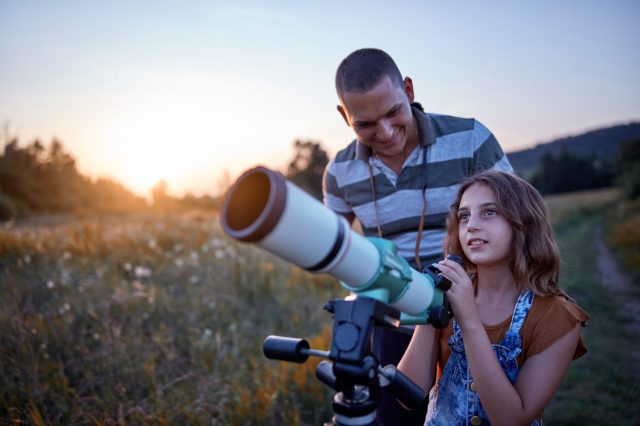
It might seem like plopping down on the grass and simply looking up would be enough—and it is if all you want is a few minutes of stargazing—but rounding up the right supplies for a night of sky-watching is essential to making your evening easy and fun. Little stargazers can get hungry, antsy, and uncomfortable, so it's best to be prepared! Here is what you'll need:
A large (preferably waterproof) blanket - Sitting directly on the ground may be scratchy and uncomfortable (not to mention you're exposing yourself to any creepy-crawlies that might be lingering below), so make sure to bring a comfy surface for the littles to lay on. Waterproof blankets help, in case the grass is wet.
Folding chairs - If you'd rather lounge than lay on a blanket, folding chairs make for comfy outdoor digs. Try to find chairs that recline, so you're not left with a stiff neck afterward.
Pillows - Lying down is, after all, the best way to get a full view of the sky, so bring along pillows to make things extra cozy!
Snacks - Little bellies need constant attention! Bring finger foods and snacks that the kids (and you!) can munch on while gazing skyward. It's best to stick to dry snacks so you won't get sticky fingers on that brand-new set of binoculars.
A Flashlight - If you're in a particularly dark spot (which is better for seeing stars), you should bring a flashlight in case you need to read a sky map, find the snacks or get your bearings. Of course, a phone works just fine, too.
Bug Spray - When the sun goes down, the bugs come out—so be prepared. For bug protection that will last the longest, the American Academy of Pediatrics recommends that kids over age two use an insect repellent containing (a maximum of 10%) Deet. For younger children and babies, use products containing Picardin, an odorless chemical safe for babies as young as two months; or natural products containing citronella, lemongrass, peppermint, and cedarwood (note: these usually need to be applied more frequently to be effective).
Star Apps - Easy apps like Night Sky or Skyview are great for finding the constellations, even when the sky conditions aren't ideal. Just hold your phone up and you'll get an AR, up-close look the constellations, satellites and planets in real-time.
S'mores - A strong recommendation from our writer's eight-year-old. Here's where you can find our favorite s'mores recipes.
Get Set Up with an Easy-to-Use Telescope or Binoculars
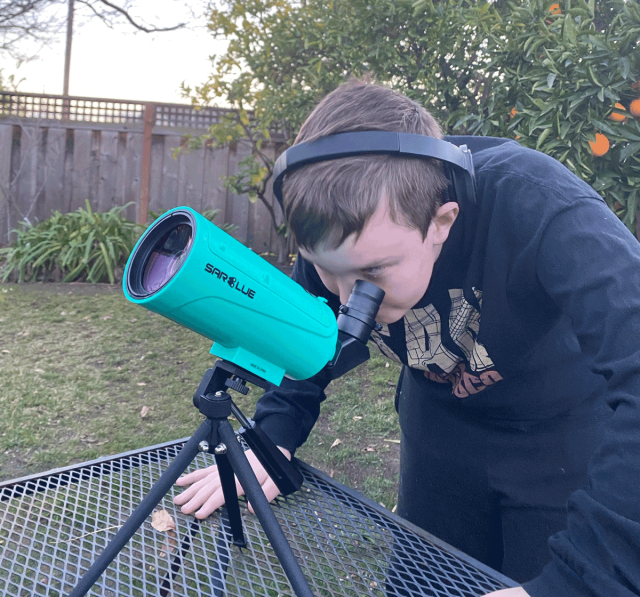
Seeing the constellations with the naked eye is fun—but it's always cooler if your kids can get a closer look. Telescopes (and binoculars, which can surprisingly offer just as good a view) are a perfect accessory to any stargazing outing.
Telescopes: There's nothing that dampens the excitement of a stargazing night than an overly complicated telescope that you're worried about the kids destroying. For stargazing with kids, we like the Maksutov-Cassegrain Telescope for its ease of assembly, ease of use, and integration with your cellphone. Bonus, its $140 price tag is not too shabby. This video shows all the steps needed to get your telescope set up. When we tried it out, we found that older kids could set it up easily including focusing and attaching their cellphones so they could take photos. The telescope can also be used in the daytime for birdwatching and other activities.
Binoculars: For binoculars, look for a pair that's 7x50 (the most popular size for skywatching). These will not only get you a view of the moon's craters but may also snag you a glimpse of Saturn's rings and Jupiter's belts.
Related: Blast Off! Inspiring Cardboard Spaceships You Can Make at Home
Figure Out Where You'll Go
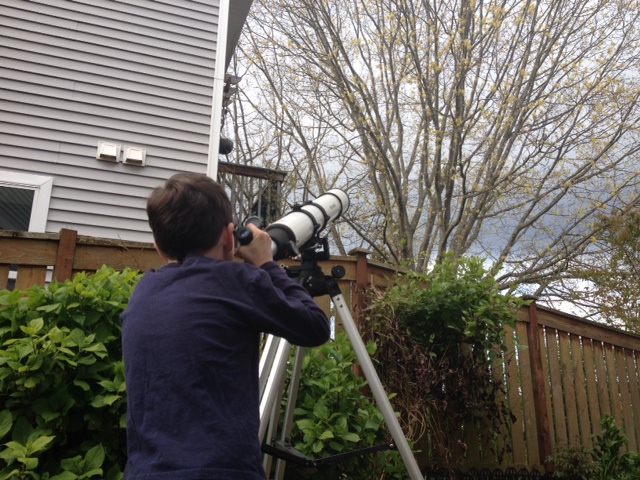
The darker the sky, the more you'll see—so it's best to get out of busy towns and cities if possible. Consider yourself lucky if you live near one of dark sky national parks, but really, any spot away from light pollution will work. State parks are usually good, safe spots to visit.
Of course, if you can't get out of your backyard, that's fine; you can usually see a scattering of stars (and the moon)—and that's a start.
Note: Wherever you go, make sure to give it time. Stargazing experts say it takes your eyes 20-30 minutes to completely adjust to the dark.
Plan the Best Time

Check the Sky Forecast - While most kids are keen to get outside on any given night, not all evenings are ideal for stargazing. Check your local forecast to see when the skies will be clear. If you want to be uber-informed, you can check out Cleardarksky.com, which publishes "astronomers forecasts" to help people find the clearest, darkest sky reports for locations all around the country (It's a bit tough to read, but once you get the hang of it, you'll be able to find the best location near you to go, plus the best time to do it.).
Pick Your Night - To find specific space events in the Southern and Northern Hemispheres, check out SpaceWeather.com, which has up-to-date forecasts. Heavens-above.com will tell you when you'll be able to spot the International Space Station—as well as other bright satellites—at your location. You can download a super-cool free map of this month's night sky at Skymaps.com (Even if your kids don't understand it, the fact that it's an actual MAP OF SPACE should make it extra-cool.).
If You Can ... Look for a Meteor Shower - There's something about those sudden streaks of light ... they make you feel lucky just for seeing them. So try to schedule your stargazing outing for a night when shooting stars are in the forecast. The Perseids Meteor Shower, which takes place every year from Jul. 24 - Aug. 24, is the best night show of the year, with up to 100 shooting stars per hour during the shower's peak, Aug. 11-13. Be sure to explain to your little astronomers that meteors aren't really "stars" at all—they're big chunks of space debris (bits of broken comets and asteroids) colliding with our Earth's atmosphere. For a list of other notable meteor showers, check out Space.com.
Start Stargazing!

So, you're outside. It's dark. You're looking up. Now what?
For New Stargazers
The first thing to explore is the moon. After all, it's Earth's best celestial buddy, and it's big enough to see without binoculars. Ask your kids if they can see the lighter splotches on the moon—then explain to them that those are the moon's mountain ranges and highlands, which are filled with humongous, city-sized craters.
For Intermediate Astronomers
Then, find the visible planets: Mercury, Venus, Mars, Jupiter, and Saturn. To tell them apart, look at the colors: Jupiter is the brightest, Saturn is usually golden-yellow, and Mars is light orange-red. For a more detailed guide on finding what's visible in the sky week-to-week (because it changes!), check out Skyandtelescope.org.
For Future Astronauts
After that, start looking for the constellations, which can vary in visibility depending on the season. For help finding these, NPR published an easy, animated how-to guide. The simplest ones to find are:
- The Big Dipper (Ursa Major)- This is usually the easiest to find, as it looks like a giant ladle in the sky.
- Polaris (a.k.a. The North Star) - If you follow the invisible line formed by the two farthest stars in the Big Dipper's saucer, it will point to the North Star.
- The Little Dipper (Ursa Minor) - The North Star is the top star in the handle of the Little Dipper. Just follow the stars down to see the curved handle and cup.
- Scorpius
Keep an eye out for man-made space inhabitants like the International Space Station and large satellites, both of which appear as small, moving stars.
Related: 7 Amazing Spots Where You Can Watch a Real Rocket Launch
Tell Your Kids These Amazing Facts about the Sky!
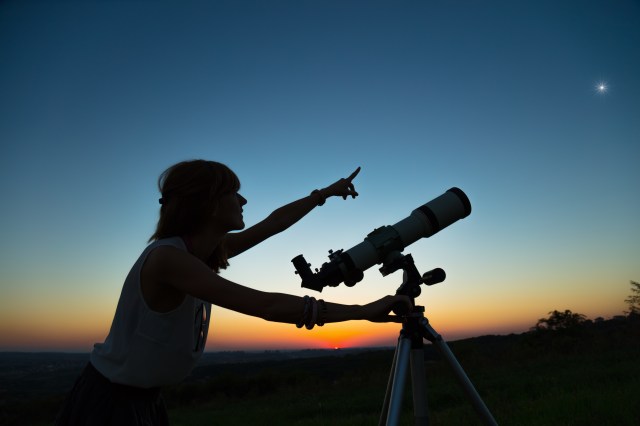
Don't know what to talk about with your kids while you're watching the stars? How about some of these amazing facts about space?
- Since the light from stars takes millions of years to reach Earth, seeing a star means you are looking millions of years back in time.
- There are approximately 200-400 billion stars in our Milky Way Galaxy alone.
- Each galaxy—and there are estimated to be more than 100 billion of them—contains hundreds of billions of stars In all, the total number of stars in the universe is possibly as high as 300 sextillion, or 300,000,000,000,000,000,000,000!
- Stars do not actually "twinkle." The twinkling appearance is only the Earth's atmosphere deflecting the light that reaches our eyes.
- When you're looking at a star, you're seeing something that's about 20 quadrillion miles away.
- There is no sound in space.
- Venus rotates so slowly that one day there is about a year on Earth time.
- There may be a planet made out of diamonds. According to research from Yale University, a rocky planet about 40 light-years away from us may have a surface made of graphite and diamond.
- Some scientists believe the moon may once have been a piece of Earth that tore off when an object smashed into our planet long, long ago.
Sources: sciencekids.co.nz, earthsky.org/space, theplanets.org
Related: Space Trivia for Kids That Is Totally Out of This World
If you buy something from the links in this article, we may earn affiliate commission or compensation.
Need some fresh ideas?
Subscribe to our weekly newsletter for expert parenting tips and simple solutions that make life instantly better.
By subscribing you agree to Tinybeans Terms and Privacy Policy
